Assault
If you’ve been charged with assault in North Dakota, you probably feel overwhelmed. You’re probably worried about how you’re going to afford bail and legal fees, what this means for your future, and whether or not your case will go to trial.
Luckily, if you’ve been charged with assault in North Dakota, you’re not alone—and there are plenty of resources out there to help you through the process from start to finish. This guide on assault charges in North Dakota will walk you through your options and explain how attorneys at Ringstrom DeKrey can help.
Table of contents
Assault In North Dakota
Simple Assault
Assault
Aggravated Assault
Terrorizing vs. Menacing
Stalking vs. Harassment
Defenses
Simple Assault in North Dakota
Most misdemeanor assault charges are actually simple assaults. If you touch another person in a way that is intended to cause them harm, you've possibly committed simple assault. For example, if you threw a punch and missed or swung at someone with an open hand and clipped them on their shoulder instead of their face, then you've possibly committed simple assault. The main distinguishing factor between simple assault and assault in North Dakota is the amount of injury you allegedly caused.
North Dakota’s simple assault laws are somewhat vague, but according the North Dakota Criminal Code, a person is guilty if they:
Willfully cause bodily injury to another person; OR
Negligently cause bodily injury to another human being by means of a firearm or weapon or some kind.
Simple assaults are typically considered Class B misdemeanors except when the alleged victim is a:
Peace officer or correctional institution employee acting in an official capacity;
An employee of the state hospital while on the job;
A person engaged in a judicial proceeding; OR
A member of a fire department or EMS unit performing their duties.
The law in North Dakota considers assaults against these individuals Class C felonies.
Simple Assault Penalties
Assaults classified as Class B misdemeanors carry a max penalty of 30 days in jail, a $1,500 fine, or both.
Penalties for Class C felony assaults could involve as much as 5 years in prison and/or a $10,000 fine.
Assault Charges in North Dakota
When most people think of assault, they think of some form of physical violence. However, assault is simply any act or threat of action which creates a reasonable apprehension in another person that he or she is about to be touched in an offensive manner.
An arrest for assault in North Dakota can range from a Class A misdemeanor to a Class C felony.
The North Dakota Criminal Code classifies assaults depending on factors such as prior record and use of weapons (both real and simulated). Any conviction will likely result in a fine, possible jail time, and an order to take anger management classes or substance abuse courses. You may also have restrictions placed on your license to carry firearms.
Assault Penalties in North Dakota
Class A misdemeanor assaults carry a max penalty of 360 days imprisonment, a$3,000 fine, or both.
Class C felony assaults carry a max penalty of 5 years in prison and/or a $10,000 fine.
Aggravated Assault
This is a serious crime in North Dakota and falls under Chapter 12.1-05 of the North Dakota Century Code. Aggravated assault is an attempt to cause bodily injury to another person by any means or force and occurs when there are substantial bodily injuries inflicted (or attempted) on another human being
A person could be charged with a Class C felony assault if they:
Willfully causes serious bodily injury to another human being;
Knowingly causes bodily injury or substantial bodily injury by using a dangerous weapon; OR
Fires a firearm or hurls a destructive device at another human being.
A person could be charged with a Class B felony assault if the alleged victim:
Is under twelve years of age;
Is a peace officer or correctional institution employee acting in an official capacity; OR
Suffers permanent loss or impairment of the function of a bodily member or organ.
Aggravated Assault Penalties
The penalties for aggravated assaults classified as a Class C felony can range from fines up to $5,000 and imprisonment for 10 years without probation or parole.
Class B felony assault penalties carry a max sentence of 10 years imprisonment and a $20,000 fine.
Terrorizing vs. Menacing
The difference between terrorizing and menacing is difficult to understand. Both involve putting someone in fear of being hurt or killed and both involve an attempt to actually follow through on that fear.
The main difference is whether or not you're actually capable of following through on that threat. If you're able to injure someone or scare them, but can't back it up, you'll likely be charged with menacing.
An example helps explain this. Think back to that bully who used to threaten your lunch money when you were young. While they may have been terrifying at first, they probably couldn't really deliver on those threats once you challenged them (they didn't want detention any more than you did). Since they weren't capable of carrying out their threats, menacing (and not terrorizing) was most likely what happened.
But sometimes conduct can be both. For example, if you hold an unloaded gun to someone's head, you could be charged with both menacing and terrorizing.
Terrorizing could also happen if a person causes the evacuation of a building, place of assembly, or facility of public transportation, or causes a serious disruption or public inconvenience.
Penalties in North Dakota
Menacing is a Class A misdemeanor and carries a max penalty of penalty of 360 days in jail and a $3,000 fine.
Terrorizing in North Dakota is a Class C felony and carries a max penalty of 5 years in prison and $10,000 fine.
Stalking vs. harassment
While both charges are considered forms of assault and can be very serious, there is a difference between harassment and stalking. Stalking is typically defined as one person following another person to harass or threaten them on a regular basis and without purpose.
Stalking is also when an individual tracks someone’s movements or location without their authorization.
Harassment, on the other hand, happens when someone intends to frighten another in writing, in person, or over the phone. This can include a threat to inflict injury, to a threat to harm someone’s reputation, or to property.
Penalties
Harassment charges can be either Class A or Class B misdemeanors and carry a max penalty of 360 days in jail and a $3,000 fine.
If found guilty of stalking, you can face a Class A misdemeanor with a max penalty of 360 days in jail and a $3,000 fine.
Individuals with previous convictions of assault, terrorizing, menacing, or harassing the same victim, or violation of a court order for a previous stalking conviction can face a Class C felony with a max penalty of 5 years in prison and a $10,000 fine.
Defenses
Since assault is a crime that may result in either a felony or misdemeanor charge depending on the circumstances, it’s important to understand North Dakota law and how it may apply to your case. There are various assault charges (physical violence, verbal threats, etc.) and every case differs depending on its facts.
Mistaken Identity
It is common for a person's memory to be unreliable. In a situation like this, the person involved will be emotional and their memory may become distorted. The details of the assault provided by the alleged victim are also sometimes inaccurate. This can lead to the accuser being mistaken. The person may "look like" their assailant due to their race or if they were in the area when the assault occurred.
Because the victim saw your face when the attack took place, they may become confused and involve you in the assault. You may be able to challenge your charge if it was a mistaken identity and you can rely on Ringstrom DeKrey to help develop this defense and help gather the evidence you need to clear your name.
Accuser’s Credibility
Attacking the accuser's credibility implies that someone is lying and their story is false. An attorney uses this defense to attack inconsistencies in testimony. By presenting contrary evidence, the attorney raises doubts.
Cases can be dismissed when you question the credibility of an accuser. As part of the credibility defense strategy, your attorney may research the victim's background or character. This could call into question the person’s credibility and whether they are telling the truth about the incident.
Alibi
In an alibi defense, evidence can be presented that you were nowhere near the alleged victim at the time of the assault. As an example, there are witnesses at the movies who remember you, or coworkers at work who can verify your attendance.
In most cases, the location is unimportant. What’s important is that you can back up your claim that you were nowhere near the victim when the attack happened. You'll need to show proof of your presence, such as movie ticket stubs or coworkers who were witness to your presence.
Affirmative Defense
An affirmative defense acknowledges that you did commit the crime, but that your actions were not a criminal act. Consent and self-defense are two examples of an affirmative defense.
Consent
If both parties consented to an activity, it is not deemed unlawful or a crime. As an example, consider a boxing match between two people in which one boxer receives unanticipated injuries and attempts to label it an attack. Because both parties agreed to participate in the bout, neither may accuse the other of assault.
Consent is a difficult defense to use. Your Ringstrom DeKrey attorney will go over your alternatives and the proof required to pursue this type of defense tactic.
Self-Defense
Self-defense is a popular defense strategy employed in assault situations. This defense seeks to demonstrate that you defended yourself against the accuser's actions. In this case, you must demonstrate that your behavior was the result of their activities. Meaning your acts were solely to protect yourself from damage.
This tactic can also be used to defend property or another person.
In addition, if the other party endangered your property, you are not guilty of assault. The property defense is commonly employed when someone breaks into your home and you must protect yourself.
Schedule a free consultation
Email: assistant@ringstromlaw.com
Tel: 218-284-0484
814 Center Ave. Ste. 5
Moorhead, MN 56560

